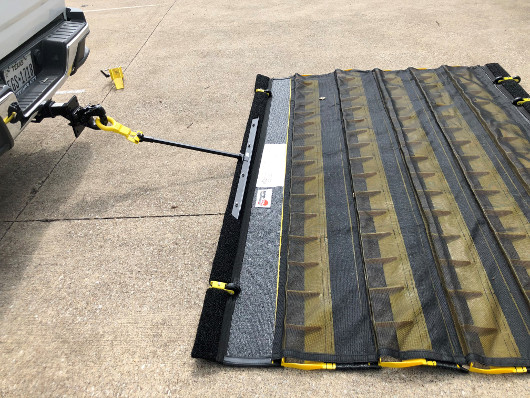Foreign Object Debris (FOD) is more than a safety concern—it’s a financial liability. In aviation, military, motorsports, and industrial sectors, undetected debris can lead to costly equipment damage, flight delays, injuries, and reputational harm. Fortunately, modern FOD prevention strategies, especially those involving high-efficiency sweepers like the FOD-Razor®, can dramatically reduce these risks and offer measurable returns on investment (ROI).
This article outlines the true financial impact of FOD and demonstrates how proactive FOD equipment investments pay off through reduced costs and enhanced operational efficiency.
Understanding the True Cost of FOD
Foreign Object Debris (FOD) remains a significant and costly issue in both the aviation and motorsport industries. According to National Aerospace FOD Prevention, Inc., FOD causes over $4 billion in annual losses for the aerospace sector alone. And these losses go far beyond just repairing damaged equipment.
Operational Downtime
When FOD is found in critical areas—like a runway, taxiway, or racetrack—operations often have to stop immediately. An airport might have to delay takeoffs or arrivals, while a motorsport facility may be forced to suspend a race or practice session. These delays disrupt tightly scheduled operations and often create a ripple effect: flight connections are missed, pit strategies fall apart, and events run behind. In high-traffic facilities, even a 15-minute delay can result in major costs, especially when dozens of people or flights are involved.
Maintenance Inefficiency
Debris left on active surfaces can quickly wear down tires, scrape undercarriages, or get pulled into engines or ventilation systems. Often, the damage isn’t noticed right away. Instead, the issue might appear later as a sudden equipment failure or safety concern. This leads to unscheduled inspections, emergency maintenance, and early part replacements—all of which increase workload, consume resources, and shorten the life of expensive assets. Facilities may also need to keep more parts in stock or run extra shifts just to keep up.
Reputational Impact
While a single FOD event may not make headlines, repeated issues can damage a facility’s reputation. Airlines may hesitate to schedule more routes through an airport that experiences regular delays or safety reports. Race teams and sponsors may take their business elsewhere if they believe the venue isn’t managing risk carefully. Even ground handling providers, freight customers, and logistics partners could lose confidence. In competitive industries, reputation is a valuable asset—and difficult to rebuild once lost.
When you account for indirect effects such as missed schedules, overtime labor, and customer dissatisfaction, the full impact of FOD becomes even more significant.
Suggested Resources
Check out our articles on Why Summer is Peak FOD Season or Training Airport Ground Crews to Combat FOD for more great ideas.
Why Investing in FOD Equipment Delivers High ROI
Lower Maintenance Costs
High-efficiency tools like the FOD-Razor®—which removes over 98% of surface debris—dramatically reduce wear and tear on tires, engines, and support vehicles. Fewer repairs and longer equipment life translate directly to lower maintenance budgets.
Fewer Operational Delays
Deploying sweepers proactively prevents costly shutdowns caused by unexpected debris incidents. Tow-behind magnetic units, for example, can clear large surfaces quickly and efficiently, keeping runways, pit lanes, and logistics areas open and productive.
Improved Safety Compliance
Meeting standards set by the FAA, ICAO, or DoD isn’t optional—and failure can be expensive. FOD equipment helps ensure ongoing compliance, reducing the risk of citations, grounding orders, or mission interruptions due to unsafe conditions.
Increased Customer and Stakeholder Confidence
A clean, controlled environment sends a strong signal. Facilities with visible FOD management programs are seen as safer and more reliable. One aircraft component manufacturer reportedly saved over $1 million annually after implementing a comprehensive FOD control strategy—and attracted new clients who valued their commitment to operational safety.
Lower Accident Liability
FOD-related incidents—such as aircraft ingesting debris or drivers hitting hazardous objects—can result in injury, equipment loss, and legal claims. Preventing these events reduces exposure to litigation and the reputational fallout that follows.
Long-Term Infrastructure Protection
FOD isn’t just a risk to vehicles; it can degrade surfaces over time. Metallic debris and sharp fragments can gouge pavement or damage drainage systems. Regular sweeping reduces this wear and extends the life of expensive infrastructure such as runways, pit lanes, and taxiway edges.
Enhanced Employee Productivity
When manual FOD walkdowns are replaced or supported by mechanical sweepers, personnel can be reassigned to more skilled or safety-critical tasks. This improves labor efficiency without compromising coverage.
Pro Tips for Maximizing ROI
Maximizing ROI from FOD control investments isn’t about the equipment alone—it’s about how well it integrates into daily operations and long-term planning. Thoughtful deployment and process alignment are what truly drive value.
Select Versatile Equipment
Use sweepers that can handle multiple areas—like runways, taxiways, pit lanes, and access roads. One well-chosen machine can often replace several, helping reduce equipment costs, simplify scheduling, and keep operations running smoothly across different parts of the facility.
Standardize Inspection Routines
Routine training and consistent checklists make inspections more reliable. Whether it’s a runway before the next flight or a track between sessions, a simple, repeatable process helps teams stay on the same page and reduces the chances of missing debris.
Track Performance with Data
Logging sweep activity, debris collected, and high-risk areas helps turn daily operations into useful insights. Even basic tracking tools can highlight patterns, support staffing decisions, and make it easier to plan budgets and equipment upgrades.
Align Sweeps with Risk, Not Routine
Sweeping should match activity, not just the calendar. Adjust your schedule based on things like aircraft movements, racing events, or weather. This ensures effort is focused where the risk is highest, without wasting time or resources.
Integrate with Maintenance Systems
FOD data becomes more useful when it’s part of your larger safety and maintenance picture. Linking debris findings to repairs or equipment use can help uncover root causes, prevent future damage, and improve facility planning.
Review ROI Regularly
Take time to measure results. Tracking costs, downtime avoided, or extended equipment life gives you a clearer view of how your FOD program is performing—and where there’s room to improve.
For more ideas on how to get the most value from your FOD control efforts, explore our article Maximizing Utilization: Getting the Most from Your FOD Equipment.
FOD Control as a Strategic Investment
Preventing foreign object debris incidents isn’t just about avoiding accidents. It’s about preserving uptime, extending equipment life, and enhancing financial performance. By investing in proven tools like the FOD-Razor®, your organization gains long-term ROI through reduced costs, safer operations, and increased stakeholder confidence.

Ready to calculate the ROI for your facility? Contact FOD Control Corporation for a site assessment or explore our full equipment line to see how we can help eliminate your FOD risks.
Visit FODControl.com to learn more or request a quote today.


